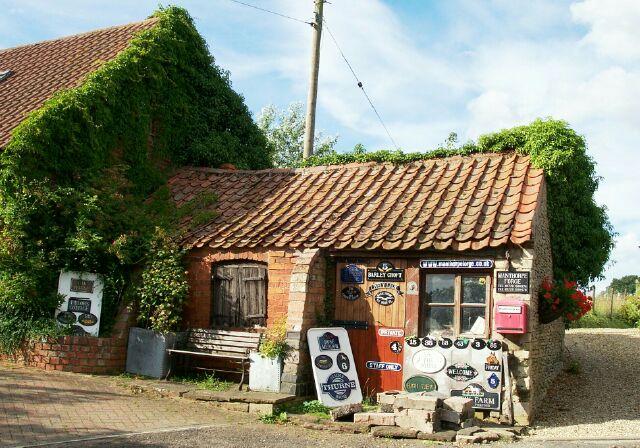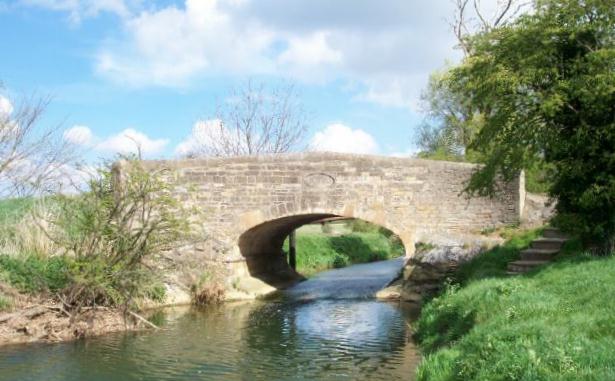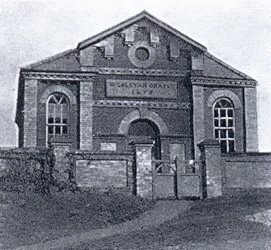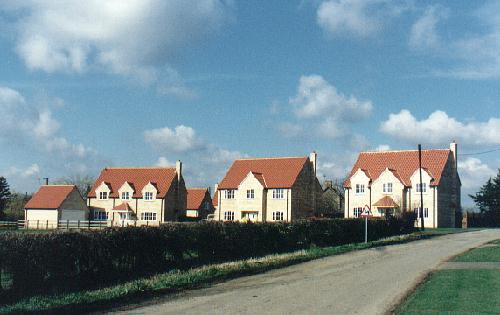|
Manthorpe
The byways of England are full of quaint buildings that serve as a reminder of the way life was before progress hurried us along at such an alarming rate and the old village forge at Manthorpe conjures up such a tranquil scene of times past. This is little more than a hamlet and there was insufficient business in the locality to support a full time blacksmith and so an itinerant farrier would arrive every few weeks to shoe the horses and this was the accommodation provided for him by the parish. The tiny red brick building with its pantiled roof survived in its original use until the last century and in 1987 it was bought by another craftsman who has established his business there, manufacturing cast aluminium house signs that are sold around the world, and examples of his work can be seen on the outside of the smithy that is known today as the Manthorpe Forge. Manthorpe nestles on a hillside just off the A6121 road to Stamford, three miles south west of Bourne, but it is a hamlet with little to offer the curious visitor except the eclectic mix of properties for it is nothing more nor less than a commuter settlement and makes no pretensions otherwise.
It is approached from the main road over an ancient and narrow bridge, one of several in the area that cross the River Glen although here the waterway is little more than a stream. Only a timber bridge existed here before the 19th century but this single span is solidly built of stone and bears the date 1813. There is no church and no public house at Manthorpe and every available piece of land is soon snapped for new housing development for sale to outsiders. The only public facilities are a telephone kiosk, a post box and a farm shop and even community events and public gatherings must be held in the next village, Witham-on-the-Hill, because there is no suitable meeting place. A Methodist congregation worshipped here during the 19th century but it no longer exists. The movement began in 1838 as a result of influence from members at nearby Toft and cottage meetings were held until 1874 when a local farmer donated land for the erection of a chapel. The stone laying ceremony was held the following year and the Lincolnshire Free Press reported on 3rd August 1875: A new chapel is being erected at Manthorpe by the Wesleyan Methodists to hold about 130 persons. Wednesday last is a day to be remembered as the time of laying the foundation stone. At three o'clock, a goodly company assembled on the spot where the Rev J Little read a portion of Scripture. A bottle containing a copy of The Watchman [the movement's magazine] and a statement of the proceedings with names of officers, etc. was duly deposited, when Mr J B Roberts presented to Mr Grimes a mallet stating that the society was not rich enough to present a silver trowel and expressing his belief that Mr Grimes would be better pleased to see the money which might have been spent on a trowel devoted to the cost of the building. In all due form, the stone was declared well and truly laid and friends present were invited to lay their offerings on the stone. An opportunity was then given of laying bricks which any person was permitted to do so on payment of one guinea. Teas were provided in a tent erected for the occasion and Mr Ansell's barn was transformed into a bazaar for fancy and useful items. A public meeting was held in the evening. Mr Pinder presided and addresses were delivered by Messrs Little, Grimes, Sneath and others. The proceeds amounted to upwards of £100 and the entire proceedings were of a most satisfactory kind. The chapel was officially opened on Thursday 30th March 1876 by the Rev T Haslam of Boston, the district superintendent. The Stamford Mercury reported on Friday 7th April: In the afternoon, he preached an excellent sermon to a large congregation. The public tea which followed was partaken by about 200 persons. In the evening there was a public meeting in the chapel, presided over by Mr Pinder, of Kirkby Underwood, when suitable addresses were delivered by the Rev E Blake (of Spalding), E Lyon (of Shepton Mallet, Somerset), and T Haslam (of Boston). The report of the contributions, &c, was read by the Rev G Swidenbank, the circuit minister. The opening services were continued on Sunday last when the Rev Joseph Little, of Alford, preached twice to large congregations. The weather on both occasions was very favourable and the total proceeds of the two days amounted to about £58. The site upon which the chapel is erected was generously given by Mr H M Ansell, of Manthorpe. The cost of the building, which has been very satisfactorily carried out by Messrs Hinson, builders, of Bourne, is a little over £400. The proceeds of the two days and donations previously received would reduce the debt upon the chapel to £160; of this um, it is hoped £60 will be procured so as to leave a debt of £100, half of which can then be obtained from one of the connexional funds without interest. The new building measured 30 ft. by 24 ft. and a Certificate of Worship had already been issued on 17th February 1876. From then on, Manthorpe became a thriving Methodist society, growing from eight members in 1875 to 22 in 1883 although its popularity was far wider and often there were up to 300 people present at evening camp meetings held during the summer months. Marriages were authorised at the chapel from June 1906 but from time, membership began to decline, despite several attempts to renew interest.
By 1964, attendance had become so reduced that services were discontinued during the winter months and in 1979, the chapel was closed and sold by auction for £1,000 to a building company who pulled it down to make way for new housing. Interestingly, the crockery from Manthorpe was taken to the Thurlby chapel where it was still in use in recent years.
There are some charming period residences in
Manthorpe but the
much restored of these cling to a fictional rural heritage with such guide
book names as the Old Cottage, the Old Bakehouse, the Gables, and
Sunnyside Cottage which does have the saving grace of a Virginia creeper
on the front wall, resplendent in its autumn colours during October.
The countryside has always had an appeal for town dwellers and their desire to move to a rural location has been a major factor in the survival of our villages. Old cottages that once would have been left to become derelict are bought and lovingly restored while many historic barns have been saved from demolition by conversion into luxury homes. Most of these opportunities have now gone and so every spare plot is regarded as ripe for residential development in the knowledge that the houses built there will quickly be sold.
Manthorpe is a village with more than its fair share of new properties and these executive homes
built on a site alongside the Wilsthorpe road during 2000 were soon snapped up by new owners anxious to sample the delights of country living. Work had finished on the new development at Manthorpe by March 2001 when all of the houses were occupied and they could be clearly seen when approaching the village from the south. Go to: Main Index Villages Index |



